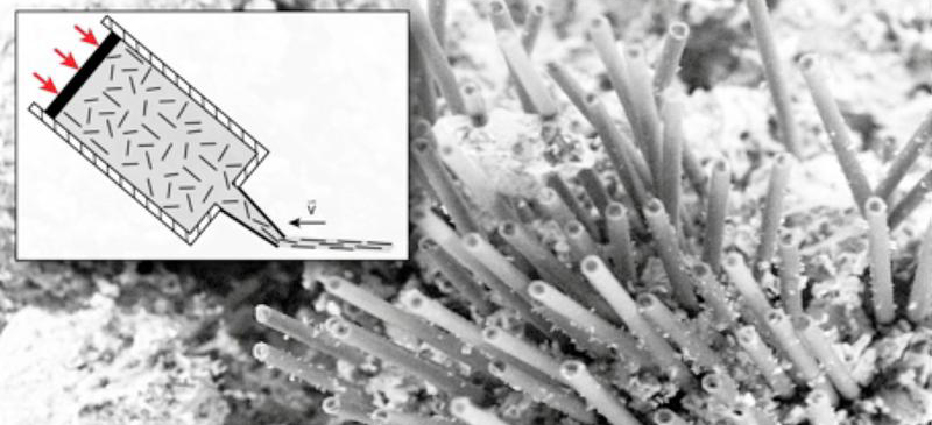
Chemists at the University of Augsburg have discovered how to manufacture an extremely strong cement at reasonable cost through use of aligned short carbon fibres.
Prof. Dr. Dirk Volkmer and fellow scientists from the Chair of Solid State and Materials Chemistry at the University of Augsburg have published a report in the Journal “Cement and Concrete Research”, describing for the first time a simple and resource-efficient technique by which a specific alignment of short carbon fibres in cementitious construction materials can be achieved.
The material produced with this process exhibits extraordinary strength, putting cement – which is actually a rather brittle material – into the same league as tough high‐performance structural biomaterials such as bone or shell. The material was developed in cooperation with the construction firm Schwenk KG, with the vision of being able to dispense with steel reinforcement in concrete construction components in the future.
Fibre-reinforced mortars and concretes are attracting ever more interest in the construction industry, as the fibre additives improve the low tensile strength of plain concrete without the need for conventional reinforcement. Carbon fibres in particular combine the advantages of low density and high resistance to corrosion with outstandingly high strength values. Up to now, however, their high manufacturing costs have meant they have not been introduced into concrete construction components on a wider scale.
When it comes to casting of fibre-reinforced concrete in moulds or formwork, the fibres are always randomly oriented. However, because load-bearing structures in building construction are in most cases subjected to loading in one direction only, a haphazard orientation of the fibres means that a considerable proportion of their potential for strength enhancement goes to waste. As Prof. Dr. Dirk Volkmer points out, “If, instead, all the fibres can be aligned in parallel along the lines of force which affect the structural element, even fibre admixtures would produce a major effect – which will also help to save resources. This was our basic concept, because similar strategies occur in nature, such as in natural bones, where the structure is suitably reinforced by aligned collagen fibres at points which come under heavy stress.”
Following on from this, Dr. Volkmer’s Augsburg research group have developed a concept which facilitates specific alignment of short carbon fibres in a mortar mixture. The team have now reported on their results in the highly respected construction industry journal “Cement and Concrete Research”
Nozzles instead of formwork and casting
The scientists adopted a new approach altogether, turning their backs on the traditional technique of casting the mortar mixture in formwork. Instead, they developed the “nozzle technique”, where the fibre-cement compound is squeezed through a narrow nozzle. The key feature here is that by adaptation of the cross section of the nozzle, a preferred orientation of the fibres can be imposed as they pass through, as can be seen in Figure 1. The short carbon fibres are oriented parallel to the direction of travel of the mortar compound as it emerges through the nozzle (see Fig. 1, inside picture).
Extremely tough and strong
“At first we simply worked on getting the most homogeneous possible distribution of the carbon fibres within the mortar mixture”, says Manuel Hambach, a Ph.D. student from Professor Volkmer’s group. “However, we rapidly discovered that homogeneous distribution alone could only achieve a limited increase in strength, because the fibres are oriented in all three spatial directions. It was only with our nozzle technique and the alignment of the fibres along the tensile force lines that we obtained a material which is extremely tough and extremely strong.”
Strength increased by 1340 %
The scientists have been able to prove that samples produced with this nozzle procedure containing 3% by volume of aligned short carbon fibres can achieve flexural strength values of up to 120 Megapascal (MPa). The Pascal is a unit for defining pressure or mechanical stress. By way of comparison, a concrete sample without fibres or steel reinforcement exhibits a flexural strength of only 8 MPa. This means that thanks to the specific fibre orientation, an increase in strength of 1340 % can be achieved, which gives the material extreme tensile strength, as Figure 2 shows.
Buildings without steel-reinforced concrete
The Augsburg researchers have also been able to show that the compressive strength, which is also a very important factor for mortar and concrete, is not adversely affected by the intentional and specific alignment of the carbon fibres. “Our mixture of cement, water, and aligned carbon fibres is the first cementitious construction material to have a flexural strength which is greater than its compressive strength. This is an important milestone in the development of building structures in which conventional steel reinforcement can be reduced, or even dispensed with altogether”, says Volkmer. “Our material exhibits high strength values which are similar to those found in the hard tissue of mammalian bones, which scientists all over the world have been trying for decades to emulate in biomimetic terms.”
Implementation by 3D printing
In order for this new material to find a way to practical application, however, it will be essential to develop technical concepts for transfer of the nozzle technique to dimensions which approach the reality of structural building components. The current process is not yet compatible with the conventional processing methods used on construction sites, as Dr. Volkmer admits. But the Augsburg scientists have a potential solution ready to hand: they see 3D printing, which is becoming more and more significant in materials research and development, as a technique with huge potential for the future. “The first prototypes of houses constructed with the aid of 3D printers have been arousing public interest for some years now”, says Volkmer. With this he is referring to the recently laid foundation stone for the new Augsburg research building, the “Materials Resource Management” (MRM) facility. This was produced by his team with a 3D printer using FIBRACRETE, the internal designation adopted for the Augsburg carbon-fibre mortar.
www.physik.uni‐augsburg.de/chemie/